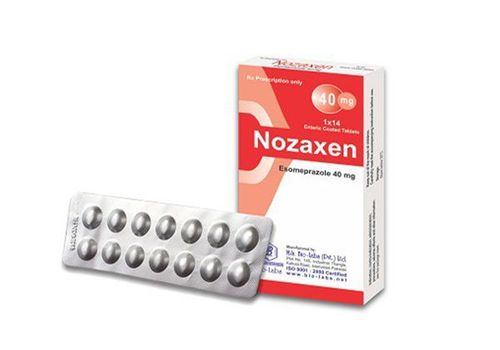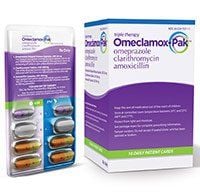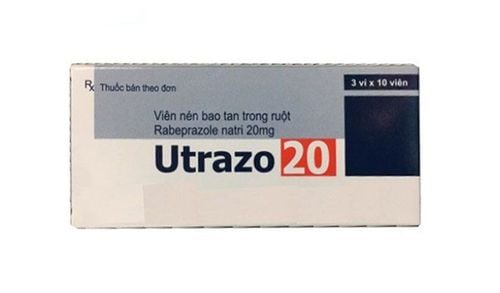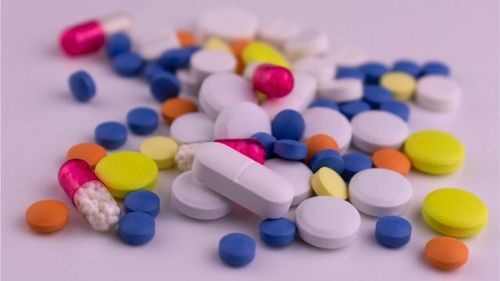This is an automatically translated article.
Langamax medicine has the main active ingredient is Lansoprazole with a concentration of 30mg Lansoprazole microparticles that are coated in the intestine. Which dosage form is suitable for direct oral administration? Packing is a box of 3 blisters, each blister contains 10 hard capsules. Langamax belongs to the group of drugs for the treatment of diseases of the gastrointestinal tract.
1. What is Langamax?
What is Langamax? Langamax medicine has the main active ingredient, Lansoprazole, with a concentration of 30mg in the form of Lansoprazole microparticles, which are coated in the intestine. The dosage form of the drug is a hard capsule containing lansoprazole microparticles coated in the intestine, suitable for direct oral use. Packing is a box of 3 blisters, each blister contains 10 hard capsules. Langamax belongs to the group of drugs for the treatment of diseases of the gastrointestinal tract.
1.1. Pharmacodynamics of active ingredient Lansoprazole Main active ingredient Lansoprazole is a benzimidazole derivative with anti-secretory effect on gastric acid. The mechanism of action of the drug Lansoprazole is to inhibit the proton pump of the gastric mucosa. Therefore, this drug is used to treat peptic ulcer disease and long-term treatment of pathological gastrointestinal hypersecretion. The main active ingredient Lansoprazole has the effect of inhibiting gastric acid secretion mainly and when stimulated by any stimulant. The degree of inhibition of gastric acid secretion depends on the dose and duration of treatment. However, the active ingredient Lansoprazole inhibits acid secretion better than H2-receptor antagonists. Lansoprazole is also used to treat gastritis caused by Helicobacter pylori infection when combined with one or more anti-infective drugs. If combined with one or more anti-infective drugs, namely Amoxicillin, Clarithromycin, Lansoprazole-containing drugs can be effective in eradicating H.pylori-caused gastritis. 1.2. Pharmacokinetics of the active ingredient Lansoprazole Active ingredient Lansoprazole is rapidly absorbed from the gastrointestinal tract, bioavailability is about 80%. Taking Lansoprazole after a meal reduces the concentration of the drug in the blood by 50%. Active ingredient Lansoprazole is about 97% bound to plasma proteins. Peak plasma concentrations are reached approximately 1.7 hours after oral administration. Lansoprazole is extensively metabolised in the liver to two major metabolites, the sulfone of lansoprazole and the hydroxy lansoprazole. These two metabolites have little or no anti-acid effect. About 20% of the active substance Lansoprazole is excreted in bile and urine. The mean elimination half-life in healthy subjects is approximately 1.5 hours, and the elimination of lansoprazole is prolonged in subjects with severe liver disease but is unchanged in those with severe renal impairment.
2. What disease does Langamax treat?
What disease does Langamax treat? Langamax drug is used in the treatment of specific diseases as follows:
Treatment of erosive esophagitis in people with gastroesophageal reflux disease. Treatment of acute gastric and duodenal ulcers caused by infection with or without infection with H.pylori bacteria. Treatment of specific pathological hypersecretory conditions such as Zollinger-Ellison syndrome, polyendocrine tumors, systemic mastocytosis. Treatment of peptic ulcers caused by the use of non-steroidal anti-inflammatory drugs or NSAIDs.
3. Usage and dosage of the drug Langamax
Usage and dosage of the drug Langamax as follows:
3.1. How to use Langamax Langamax drug is prepared in the form of hard capsules containing Lansoprazole microparticles coated in the intestine, suitable for direct oral use. You should take the pill in the morning before eating, do not break or chew the tablet when using. 3.2. Dosage of the drug Langamax Dosage to treat erosive esophagitis caused by gastroesophageal reflux disease with adults use 1 tablet / day, for a period of 4 to 8 weeks and can be used for another 8 weeks if not from. Dosage for treatment of peptic ulcer is 1 tablet/day for 4 to 8 weeks. Dosage for treatment of pathological acidosis is 60mg (equivalent to 2 tablets), taken once a day, then adjust the dose according to tolerance and continue treatment until clinical results are achieved. use from 1 to 6 tablets / day (divided into 1-2 times orally) Dosage to treat stomach ulcers while taking NSAIDs is 1 tablet / day, taken for 8 weeks. For people with severe liver failure, the dose should be reduced. The maximum dose is 30 mg/day. It should be noted: The above drug dosage is for reference only, patients need to go to medical facilities for examination, consultation and prescription for the most appropriate use of the drug.
3.3. Overdose and Overdose Management The effects of Langamax overdose in humans have not been clearly established. Treatment: in case of suspected overdose, the overdose user should be carefully monitored. At present, there is no specific antidote for Langamax overdose. If necessary, the treating doctor will prescribe gastric emptying, using activated charcoal and symptomatic treatment. Dialysis does not remove the drug from the body.
4. Undesirable effects of the drug Langamax
During the use of Langamax, users may experience some unwanted effects, specifically as follows:
The most common reactions to drugs containing Lansoprazole active ingredient are in the gastrointestinal tract such as disturbances. digestion, diarrhea, abdominal pain. In addition, some patients have headache and dizziness. Other common reactions include nausea, vomiting, constipation, dyspepsia, rash. Other rare reactions include fatigue, increased serum gastrin, liver enzymes, hematocrit, hemoglobin, uric acid and proteinuria.
5. Interactions of drugs Langamax
In the process of using Langamax, it is necessary to pay attention when using it in combination with other drugs, specifically as follows:
5.1. Drugs Absorption Depending on Stomach pH Atazanavir: Active ingredient Lansoprazole significantly reduces the absorption of Atazanavir when used concomitantly; Langamax should not be used concurrently with Atazanavir. Ketoconazole and Itraconazole drugs: Langamax drugs reduce the absorption of Ketoconazole drugs, Itraconazole Digoxin drugs: Langamax drugs increase the absorption of Digoxin drugs when used simultaneously, leading to increased plasma concentrations of Digoxin. Therefore, it is necessary to adjust the therapeutic dose of Digoxin when starting and ending treatment with Langamax. 5.2. Drugs Metabolized by cytochrome P450 Drugs containing the active ingredient Lansoprazole may increase plasma concentrations of drugs metabolised in the liver by the enzyme CYP3A4 and should be used with caution. Theophylline: Concomitant use with Langamax may reduce the plasma concentration of Theophylline,. Depending on each specific case, the treating doctor will prescribe a dose adjustment of Theophylline when starting or stopping the use of Langamax to ensure a clinically effective drug concentration. Tacrolimus: Concomitant use of Langamax and Tacrolimus may increase the concentration of Tacrolimus in the blood. 5.3. Interactions with other medicinal products CYP2C19 inhibitors such as fluvoxamine: increases plasma concentrations of drugs containing the active ingredient lansoprazole, so a dose reduction may be necessary when these two drugs are administered concomitantly. to CYP2C19 and CYP3A4 such as Rifampicin, St John's wort (Hypericum perforatum) may decrease the plasma concentration of the active ingredient Lansoprazole. Warfarin: There have been reports of an increase in prothrombin time and INR in concomitant use of Warfarin with Lansoprazole, which may lead to abnormal bleeding, requiring close monitoring. Sucralfate slows and reduces the absorption of the active ingredient Lansoprazole, so Langamax should be taken at least 1 hour after using this medicine. Co-administration of Langamax with Methotrexate (in high doses) may increase blood levels of Methotrexate and/or its metabolites, possibly leading to Methotrexate toxicity.
6. Some notes when using Langamax drug
When using Langamax, patients need to pay attention to some of the following:
6.1. Contraindications of the drug Langamax People with a history of hypersensitivity or severe hypersensitivity to the components of the drug. Hypersensitivity reactions may include angioedema, anaphylaxis, bronchospasm, acute interstitial nephritis or superficial urticaria. 6.2. Precautions when using Langamax Use caution when using Langamax in people with moderate and severe liver dysfunction. Langamax should not be used in case of malignancy of the gastrointestinal tract, because the effect of the drug obscures the symptoms of the disease, hindering the diagnosis. Interstitial nephritis can occur at any time during proton pump inhibitor therapy and is usually due to an idiopathic hypersensitivity reaction. Discontinue treatment with Langamax if acute interstitial nephritis develops. Treatment with Langamax may lead to a slight increase in the risk of gastrointestinal infections such as Salmonella and Campylobacter If treatment with Langamax is combined with antibiotics for the treatment of peptic ulcer disease caused by H.pylori, the treatment should be directed at treatment. The use of antibiotics should also be monitored. Because safety data are limited for those on maintenance therapy longer than 1 year, frequent treatment evaluations and comprehensive risk/benefit assessments should be routinely performed in these populations. . Very rare cases of colitis have been reported in people treated with Langamax. Therefore, in case of severe and/or persistent diarrhea, treatment should be discontinued. The use of Langamax for the treatment of peptic ulcers in those requiring continuous NSAID therapy should be limited to those at high risk of: prior bleeding, perforation or ulceration of the gastrointestinal tract; advanced age; concomitant use with drugs that have adverse effects on the gastrointestinal tract (eg, corticosteroids or anticoagulants); the presence of a serious pathogenic factor; Prolonged use of NSAIDs at the maximum recommended dose. Severe magnesium deficiency has been reported in subjects treated with proton pump inhibitors specifically Langamax for at least 3 months and in most cases for more than 1 year. Serious symptoms include fatigue, tetany, delirium, dizziness, arrhythmias, and seizures. Proton pump inhibitors (PPIs), particularly Langamax, if used in high doses and for a long time (more than 1 year) may slightly increase the risk of hip, arm, and spine fractures, mainly in tall people. age or have other risk factors. People who are suffering from arthritis, are at risk of fractures, osteoporosis, old age should be monitored and supplemented with calcium and vitamin D. Warning related to excipients: Mannitol may cause a condition. mild laxative. This medicine contains sucrose, so people with hereditary problems of fructose intolerance, glucose-galactose malabsorption or sucrose-isomaltase deficiency should not take this medicine. 6.3. Using the drug with drivers, pregnant and lactating women Effects of drugs on drivers and operating machines: Use Langamax with caution, unwanted drug reactions such as flowers eyes, dizziness, visual disturbances, and somnolence may occur. Pregnancy: To date, there are no adequate studies on the use of Langamax in pregnant women. Studies performed in animals have shown no direct or indirect harm with respect to pregnancy, embryo/foetal development, parturition or neonatal development. However, Langamax is not recommended for pregnant women. Lactation: Studies performed in animals have shown excretion of the main active ingredient Lansoprazole in milk. Careful consideration should be given to whether to continue/discontinue the drug while breast-feeding or to continue/discontinue taking the drug against the benefit of – breast-feeding and the benefit/risk of treatment with Langamax. Store Langamax in a dry place, away from direct light. Besides, it is necessary to keep Langamax medicine out of reach of children and family pets. Absolutely do not use Langamax medicine after the expiry date.
Langamax medicine has the main active ingredient is Lansoprazole with a concentration of 30mg Lansoprazole microparticles that are coated in the intestine. Langamax belongs to the group of drugs for the treatment of diseases of the gastrointestinal tract. When prescribed medication, patients should carefully read the instructions for use, consult a doctor / pharmacist before using the drug. Absolutely do not arbitrarily buy Langamax medicine to treat diseases at home, because there may be unwanted side effects to health.
Follow Vinmec International General Hospital website to get more health, nutrition and beauty information to protect the health of yourself and your loved ones in your family.













